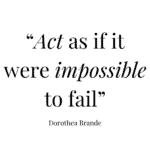Act As If It Were Impossible To Fail – Dorothea Brande Quote Meaning
Act as if it were impossible to fail.
Dorothea Brande
You know when you read motivational quotes and sometimes just think, “Okay, but how is just ‘acting’ like I can do it going to help me actually get there?” It sounds a bit too good to be true, right?
But, hear me out on this. Dorothea Brande, in her book Becoming A Writer, gave us a gem that goes a bit deeper. In her full version of this popular quote, she says;
“All that is necessary to break the spell of inertia and frustration is this: Act as if it were impossible to fail. That is the talisman, the formula, the command of right-about-face which turns us from failure towards success.”
It’s like she’s handing us a secret key, showing us a way to flip our mindset from expecting to fail, to moving towards our goals like we’ve got this in the bag!
But, it’s not about just pretending everything’s fine and waiting for magic to happen. Brande writes of something that we all deal with: getting stuck, being scared of messing up, or just putting things off.
Instead, she’s saying, “Hey, why not approach things like you’re bound to succeed?”
And you know what? Believing in ourselves, having a bit of faith (not necessarily the religious type), can be super powerful. It’s like when you really think you can nail something, you kind of just start rolling with it. And get it done.
So, when Brande talks about ‘acting,’ she’s not just throwing out a verb. It’s about the action, sure, but it’s also about how we see ourselves in the story of our own goals.
It’s about becoming the person who’s not just going through the motions, but someone who’s all in, come what may.
Let’s discuss further, and find some actionable tips from this powerful quote.
Origin of The Quote
The quote “Act as if it were impossible to fail” was written by Dorothea Brande, an American writer and editor, best known for her book Becoming a Writer published in 1934. Her approach encouraged writers to push beyond self-doubt, and practice positive visualization – well before these became mainstream concepts in personal development.
Like any quote, or ‘advice’, it’s important to consider the era in which it was written (during the Great Depression), and to consider bias, perception, privilege and social and cultural contexts. The following interpretation is my own opinion, and as always, I invite you to share your perspectives too in the comments below.
The Power of Belief And Action

When we dive into the heart of what it really means to ‘act as if it were impossible to fail,’ we uncover a powerful duo: belief and action.
Not just feel-good buzzwords – they’re the engine and fuel that can drive us toward our goals, and there is science-backed research which backs this up.
Belief as a Catalyst – Self-efficacy
First up, let’s talk about belief. It’s not just about hoping or wishing – it’s about genuinely holding onto the strong belief that you’ve got this. It’s now possible.
This kind of belief isn’t just fluffy optimism—it’s backed by some solid psychology. Take self-efficacy, for example. This concept, introduced by psychologist Albert Bandura, suggests that when we believe in our own ability to succeed at specific tasks, we’re more likely to take on challenges and persevere through difficulties.
It’s like if you’re convinced you can nail a presentation, you’re more likely to do the research, practice your delivery, and walk in there ready to nail it. You experience a natural inspiration and motivation towards doing the tasks you need to do.
Action Beyond Pretense – Self-fulfilling prophecy
Now, moving on to action. ‘Acting as if’ isn’t about putting on a mask, or pretending to be someone you’re not. It’s about stepping into the shoes of your best, most confident self.
It’s about making moves with the assurance of someone who believes failure isn’t in the cards. This is where the magic happens, because when you start acting with that kind of confidence, your actions begin to align with your goals.
This idea ties in well with the concept of a self-fulfilling prophecy.
Basically, if you start the day thinking you’re going to nail all your tasks, you approach them with a positivity and energy that often leads to just that outcome. On the flip side, if you’re convinced you’ll flail, your lack of effort, or half-hearted attempts, tend to lead to the very failure you feared.
The Role of CBT
Let’s not forget the insights from Cognitive Behavioral Therapy (CBT), which is all about challenging and changing unhelpful cognitive distortions and behaviors, improving emotional regulation, and developing personal coping strategies that target solving current problems.
CBT teaches us that our thoughts, feelings, and behaviors are interconnected, and by shifting our thought patterns and actions, we can influence our emotions and outcomes.
Applying this to ‘acting as if,’ if we change our actions and attitudes to those of success, we can shift our thought patterns and emotions in a positive direction.
By embracing belief and action, backed by the solid principles of self-efficacy, self-fulfilling prophecy, and CBT, we’re not just dreaming of success; we’re stepping into the role of someone who’s already there.
And that, my friends, is where the real transformation begins.
Applying the Quote to Everyday Life
By putting these tips into practice, the idea of ‘acting as if it were impossible to fail’ becomes an actionable strategy, fostering a positive cycle of belief and action that moves you closer to your objectives:
- Visualize Success: Daily, take a moment to vividly imagine achieving your goals, focusing on the feelings and the environment. This visualization prepares your mind for success.
- Set Small Goals: Break your main goal into smaller, achievable steps. Each small success reinforces your confidence and commitment to the ‘act as if’ mindset.
- Adopt Successful Habits: Identify and gradually integrate the habits of those who’ve achieved your goals into your routine, such as adjusting your schedule or networking.
- Dress the Part: Wearing attire that reflects your goal can boost your psychological state. Dress in a way that makes you feel capable and confident.
- Seek Support: Share your ambitions with supportive friends or family. Their belief in you can strengthen your own confidence.
- Reflect and Adjust: Continuously evaluate your progress and fine-tune your approach, ensuring your actions always align with the ‘act as if’ mindset.
Personal Goal Example: Running A Marathon
I love a good example of how to apply a theory or concept to a real life goal…this is a current goal of mine:
Imagine you’ve set your sights on running a marathon, a goal that feels daunting, especially if your current running experience is limited to short jogs or occasional sprints.
The distance alone—26.2 miles (or 42 km give or take)—can seem overwhelming.
However, by embracing the ‘act as if’ mindset, you can gradually align your daily actions with those of a seasoned marathoner, making the goal much more attainable.
Working Back from the Outcome:
Begin by envisioning the finish line—not just as a distant dream, but as an inevitable outcome. Picture yourself crossing it, the crowd cheering, your body flooded with a mix of exhaustion and exhilaration.
With this clear image in mind, start to work backward: What steps did “future you” take to get there? This reverse engineering can clarify the path ahead.
Adopting Marathon Runner Habits:
- Training Schedules: Set up a structured training plan that progressively increases your distance and endurance. Marathon training plans are abundant on the internet and can be tailored to various skill levels. These plans often start small and gradually build up the mileage, mirroring how you’ll incrementally adopt the identity of a marathon runner.
- Nutrition and Hydration: Learn about the dietary needs of long-distance runners. This includes understanding the importance of carbohydrates for energy, proteins for muscle repair, and staying well-hydrated to maintain performance. Experiment with different meals and hydration strategies during your training runs to find what works best for you.
- Rest and Recovery: Acknowledge the importance of rest days and recovery practices in your routine. Experienced runners know that pushing too hard without adequate rest can lead to burnout or injury. Incorporate rest days, engage in stretching or yoga, and consider activities like foam rolling to aid in recovery.
- Join Shared Communities: Connect with running communities, both locally and online. Surrounding yourself with fellow runners provides a support network, valuable insights, and the camaraderie of shared experiences. It’s also a great way to stay motivated and accountable.
- Gear and Equipment: Invest in the best quality running gear you can, including shoes that suit your gait and provide the necessary support. Dressing the part enhances your commitment and help prevent injuries.
- Mental Preparation: Running a marathon is as much a mental challenge as it is a physical one. Practice visualization techniques and positive self-talk during your runs. Break down the marathon into smaller segments mentally to make it more manageable.
Embracing the Marathon Mindset:
By adopting these habits and integrating them into your daily life, you start to embody the essence of a marathon runner. Each day, with each training session, you’re not just preparing your body for the marathon; you’re reinforcing the belief in your ability to achieve this goal.
It’s no longer a matter of “if” you can run a marathon, but “when.” The transformation in self-identity is subtle but profound. As you inch closer to the marathon date, you’ll find that the habits you’ve adopted have not just prepared you for the race but have woven into the fabric of your everyday life, affirming the powerful mantra: “I am a runner.”
Potential Limitations
The quote carries powerful inspiration, but it can also be misunderstood or misrepresented in several ways, such as:
Like anything, to fully embrace and benefit from the wisdom of this quote, it’s important to balance optimism and confidence with pragmatism.
Final Thoughts
In conclusion, Dorothea Brande’s encouragement to “Act as if it were impossible to fail” is a call to blend unwavering belief in our own capabilities with decisive action, so it propels us forward with momentum.
I would love to hear your thoughts on this quote, feel free to comment below!






